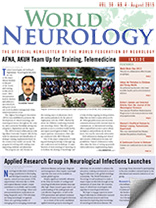By Torrey Boland, MD

Torrey Boland
Despite the publication of evidence-based practice parameters for the declaration of brain death by the American Academy of Neurology (AAN) in 1995 and updated in 2010, there remains much variation worldwide in how the actual determination of brain death is performed. Not only does the practice, but also the perceptions of brain death, vary widely across countries.
In 2002, an international review identified significant variations in the practice of determining brain death. However, studies such as this have reported primarily on higher-income regions.
Earlier this year, several researchers reported in Neurology the results of the largest study to date attempting to assess and characterize both the practices in determination of brain death worldwide as well as the perceptions of brain death among countries. This study aimed to gather data not only from high-income countries, but to gather a comprehensive worldwide dataset. It confirmed that significant variations continue to exist worldwide in both the perception and practice of declaration of brain death. This lack of agreement could become challenging as organ transplantation networks are becoming increasingly internationalized, and supports the need for a stronger international consensus on brain death.
The authors conducted an electronic survey, which was distributed to individuals who practiced medicine and had interactions with patients who could become brain dead. The target participants comprised physicians in 123 countries. The survey sought to query individuals with knowledge and expertise in brain death within each country. Included in the survey were members of the Neurocritical Care Society; country representatives of the World Federation of Neurology, who were asked to either complete the survey or forward it to appropriate colleagues, authors of publications on brain death; and international personal contacts of the authors. Responses were tallied from 91 countries, including the African, Eastern Mediterranean, European, Pan-American, Southeast Asian and Western Pacific World Health Organization regions.
The findings of the study showed that there remains significant variability in both the perception of brain death as a concept as well as dissimilarity in the practice of the declaration of brain death. Most countries noted a legal provision (70 percent) and an institutional protocol for the declaration of brain death (77 percent), but high-income countries were significantly more likely to have an institutional protocol than low-income countries.
In addition, the majority of countries in Africa lacked institutional brain death guidelines. Legal provisions for brain death were more likely in countries with organized transplant networks, even when adjusting for income. This may be related to advances in medical technology, which has led to an increase in organ transplantation in more middle- and low-income countries. This rise in transplantation indicates a corresponding need for understanding of the concept of brain death.
A small portion of countries (14 percent) reported a lack of brain death declarations in their hospitals, citing a lack of intensive care or advanced technology, lack of expertise in brain death, and uncertainties regarding the concept of brain death. This may represent a need for further
medical education in some areas of the world. Interestingly, 57 percent of respondents disagreed with the statement that brain death equates to cardiac death. This response did not appear to be associated with country income level, which may reflect variations among individuals related to personal or cultural beliefs. Nearly all physicians from countries with designated transplant networks agreed that brain death was an established concept at their hospitals.
Variations in the practice of declaring brain death were noted as well. While the majority (66 percent) of respondents reported that an attending physician trained in neurology, neurosurgery or intensive care must make the determination of brain death, 25 percent of those polled stated that a resident-level trainee could independently declare brain death. Discrepancies were noted in the clinical examination, with more than half of the countries citing an institutional protocol that was discordant with the 2010 American Academy of Neurology criteria. Apnea testing was another area in which much variability existed, with differences in blood gas requirements, number of tests required and equipment.
There did not seem to be an association between the use of ancillary testing and country income level. The authors hypothesized that this finding may be explained by the increased use of ancillary tests by physicians who are unfamiliar with brain death, as the AAN practice parameter does not require ancillary testing in straightforward cases.
While this study depended on the responses of individuals, there may be a bias in the nature of self-reported perceptions and practices. The results may not reflect each country as a whole, and there may be regional differences within each country that were not assessed. In addition, the survey was presented in English only, which may have led to some misinterpretation in the questions by responders. In the lowest income countries, the need for a policy surrounding the declaration of brain death may be irrelevant as there are more urgent public health issues. Overall, however, this study represented a large, diverse and worldwide sample.
Variations in brain death declaration both in practice and as a concept persists despite advances in communication and education worldwide. This study identifies the challenges in developing a worldwide consensus on the determination of brain death. It is unclear whether creating an international standard for brain death is a feasible goal. In addition to variations in medical education, cultural beliefs and legal codes worldwide, there are also individual differences in practice and beliefs, as evidenced by variations in practice within the United States, which may be related to individual biases and opinions. This study highlights the need for the international community to work together to create a more uniform approach to brain death, especially as the practice of organ donation continues to expand.
Reference
Wahlster S, Wijdicks EFM, Patel P, et al. Brain death declaration. Neurology 2015; 84:1870-1879.
